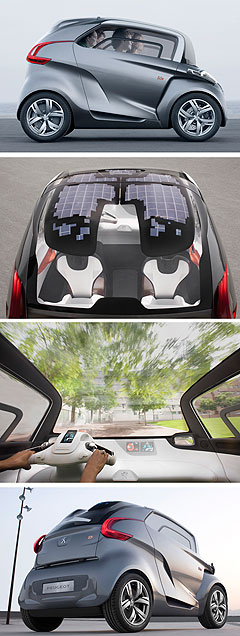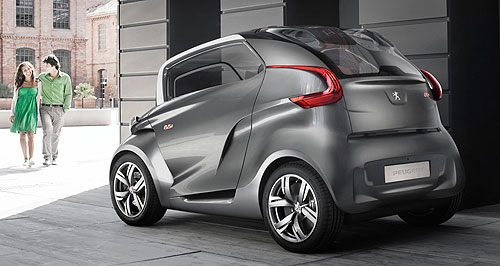Make / Model Search
Future models - Peugeot - BB1Frankfurt show: Pugnacious Pug a minnow miracleSmall stuff: The aggressive styling of the Peugeot BB1 Concept disguises a tiny vehicle, just 2.5 metres long, with big interior. Peugeot BB1 electric commuter concept seats four in 2.5-metre cabin17 Sep 2009 PEUGEOT has borrowed expertise from its partners at Peugeot Motorcycles to develop one of the most innovative city-car solutions to go on show at this year’s Frankfurt motor show. With a motorcycle-style tubular steel frame and handlebar driving controls, the electric-powered Peugeot BB1 Concept shrinks the urban commuter to just 2.5 metres long – about 19cm shorter than the current sawn-off champion, the Smart ForTwo – and 1.6 metres wide (slightly wider than the 1.55-metre Smart). But unlike the two-seater Smart, the Peugeot BB1 packs accommodation for four with what Peugeot describes as “record use of interior” – a combination of innovating thinking and short cuts that might never trouble a production line. With no foot pedals, the BB1 achieves a more vertical driving position, meaning the legs do not need as much stretch room. A twist-grip-type throttle controls the speed, while braking is via handlebar lever. Seating is conventional 2+2, but the seat backs are ultra-narrow, freeing up space in the cabin. The rear-seat passengers sit with their knees akimbo, on either side of the front-seat occupants, in another motorcycle inspiration that saves space.  The front seat backs fold forward so rear-seat passengers can clamber over the front seats into the rear compartment. The front seat backs fold forward so rear-seat passengers can clamber over the front seats into the rear compartment.Access is via large side doors that swing open from the front – ‘suicide’ style - while a conventional rear hatch opens to the rear luggage compartment, which holds a minimal 160 litres when the rear seats are in use. This can be opened up to 855 litres by folding up to three seats. In what is becoming a Peugeot trademark, the BB1 has a panoramic, high-brow windscreen that wraps over the heads of the front occupants, in similar fashion to the “double-bubble” roof of the new Peugeot RCZ sports car. Powered by lithium-ion batteries under the seats and driven by two 7.5kW electric motors – one in each rear wheel – the BB1 can bolt from a halt at the traffic lights to 30km/h in 2.8 seconds (no 0-100km/h time is quoted, as the top speed is 90km/h). Range is 120km – fairly typical for an EV. Despite a not inconsiderable battery weight of 100kg, the BB1 tips the scales at just 600kg – about 200kg lighter than the petrol Smart ForTwo. Part of the weight saving has come from use of hi-tech carbon body panels fixed to the space-frame structure. Like most electric or hybrid vehicles appearing today, the BB1 has solar cells fixed to the roof to generate power to ventilate the car when parked in the sun and supply a trickle current to some of the car’s electrical systems. Peugeot claims the solar panels are flexible – moulding to rounded surfaces – and more efficient that other current solar cell technologies, converting 16 per cent of captured solar energy in electricity. The in-wheel electric motors were developed by tyre-maker Michelin, which also supplied the low-rolling resistance tyres. City maneuverability was one of the major goals of the BB1 designers, who have endowed the BB1 with a turning circle of just 3.5 metres – less than half that of the conventional 10-metre turning circle of a small car. This has been achieved in part with a motorcycle quad-bike steering set up that inspired much of the package. Another source of inspiration was a 1940s Peugeot called the VLV – a basic three-wheel transport turned out by the French manufacturer during the dark days of World War 2, when both resources and customer finances were scarce. Like the BB1, the VLV was also electric powered to counter fuel restrictions in France at the time. Only 377 VLVs were built between 1941 and 1945. It remains to be seen if the BB1 can surpass that number, as Peugeot has not indicated if the new iteration will make it into production.  Read moreAll future models Alfa Romeo Alfa Romeo Abarth Abarth Alpine Alpine Alpina Alpina Audi Audi Aston Martin Aston Martin BMW BMW Bentley Bentley Chery Chery Brabham Brabham Chrysler Chrysler Chevrolet Chevrolet Cupra Cupra Citroen Citroen DS DS Dodge Dodge Fiat Fiat Ferrari Ferrari Foton Foton Ford Ford Great Wall Great Wall FPV FPV Haval Haval GWM GWM Honda Honda Holden Holden Hummer Hummer HSV HSV Infiniti Infiniti Hyundai Hyundai Jaguar Jaguar Isuzu Isuzu Kia Kia Jeep Jeep Land Rover Land Rover Lamborghini Lamborghini Lexus Lexus LDV LDV Mahindra Mahindra Lotus Lotus Mazda Mazda Maserati Maserati Mercedes-AMG Mercedes-AMG McLaren McLaren MG MG Mercedes-Benz Mercedes-Benz Mitsubishi Mitsubishi Mini Mini Opel Opel Nissan Nissan Peugeot Peugeot Pagani Pagani Proton Proton Porsche Porsche Renault Renault Ram Ram Rover Rover Rolls-Royce Rolls-Royce Skoda Skoda Saab Saab SsangYong SsangYong Smart Smart Suzuki Suzuki Subaru Subaru Toyota Toyota Tesla Tesla Volvo VolvoMotor industry news |
Click to sharePeugeot modelsResearch Peugeot All future models Alfa Romeo Alfa Romeo Abarth Abarth Alpine Alpine Alpina Alpina Audi Audi Aston Martin Aston Martin BMW BMW Bentley Bentley Chery Chery Brabham Brabham Chrysler Chrysler Chevrolet Chevrolet Cupra Cupra Citroen Citroen DS DS Dodge Dodge Fiat Fiat Ferrari Ferrari Foton Foton Ford Ford Great Wall Great Wall FPV FPV Haval Haval GWM GWM Honda Honda Holden Holden Hummer Hummer HSV HSV Infiniti Infiniti Hyundai Hyundai Jaguar Jaguar Isuzu Isuzu Kia Kia Jeep Jeep Land Rover Land Rover Lamborghini Lamborghini Lexus Lexus LDV LDV Mahindra Mahindra Lotus Lotus Mazda Mazda Maserati Maserati Mercedes-AMG Mercedes-AMG McLaren McLaren MG MG Mercedes-Benz Mercedes-Benz Mitsubishi Mitsubishi Mini Mini Opel Opel Nissan Nissan Peugeot Peugeot Pagani Pagani Proton Proton Porsche Porsche Renault Renault Ram Ram Rover Rover Rolls-Royce Rolls-Royce Skoda Skoda Saab Saab SsangYong SsangYong Smart Smart Suzuki Suzuki Subaru Subaru Toyota Toyota Tesla Tesla Volvo VolvoMotor industry news |










Facebook Twitter Instagram